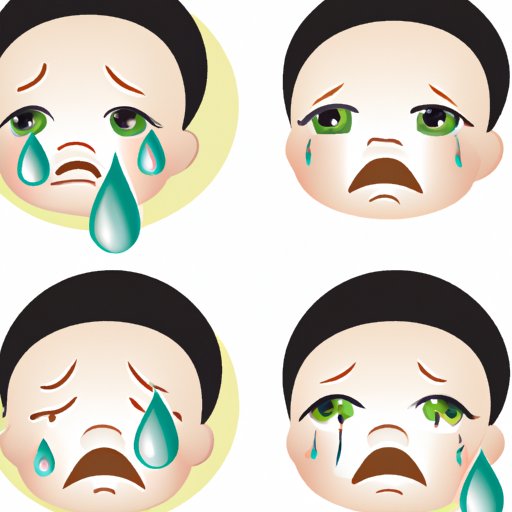Introduction
Crying is a universal expression of emotion that has captivated people throughout history. From ancient rituals to modern movies, weeping has been used as a way to convey sadness, joy, and everything in between. But what is the science behind crying? How do our bodies and minds react when we shed tears?
In this article, we will explore the physiological, psychological, and cultural significance of crying. We will look at how hormones, neurotransmitters, and brain regions influence our emotional responses and how tears play a role in human development. We will also examine the emotions associated with weeping and the rituals and taboos surrounding tears. Finally, we will discuss the potential benefits of crying and its impact on our overall well-being.

Understanding the Physiological Effects of Crying
When we cry, our body undergoes several physical reactions. The most obvious response is the production of tears, which are made up of water, oils, and mucus. These components help keep our eyes moist and protect them from irritants and infections. When we cry, our tear glands produce more of these components to lubricate our eyes and flush out any foreign particles.
Hormones also play an important role in weeping. Specifically, our bodies release three hormones during crying: adrenocorticotropic hormone (ACTH), prolactin, and endorphins. ACTH is released in response to stress and helps regulate our mood and energy levels. Prolactin is released to reduce stress levels and promote relaxation. Endorphins are released to stimulate feelings of pleasure and reduce pain.

Exploring the Psychology of Tears
Crying is not just a physical reaction; it is also a psychological one. Our brains are constantly processing emotions and responding to them in various ways. When we experience intense emotions, our brains experience a surge of activity in certain areas, such as the prefrontal cortex and amygdala. This activity helps us recognize and respond to our emotions.
Studies have also shown that the brain’s reward system plays a role in crying. According to research, tears can activate the same reward pathways in the brain as laughing and playing. This suggests that crying can be pleasurable, even if it is associated with negative emotions.

Examining the Role of Crying in Human Development
Crying plays an important role in human development. For infants, crying is their primary form of communication. They use it to signal hunger, discomfort, or distress to their caregivers. As children grow older, they learn to express their emotions in other ways, such as talking or writing. However, crying remains an important part of emotional expression throughout life.
Research suggests that crying can also have a positive effect on mental health. Studies have found that crying can reduce stress, improve mood, and even boost the immune system. Additionally, crying can help people process difficult emotions and cope with challenging situations.
Investigating the Neurochemical Reasons Behind Weeping
Neurochemicals also play an important role in emotional expression. Neurotransmitters, such as serotonin and dopamine, help regulate our moods and emotional responses. Neuropeptides, such as oxytocin and vasopressin, help regulate our social behavior and attachment to others.
Brain regions are also involved in emotional expression. Several areas of the brain, including the amygdala, hippocampus, and prefrontal cortex, are activated when we cry. These regions help us recognize and respond to emotions, as well as regulate our behavior.
Analyzing the Emotions Associated with Crying
Crying is often associated with sadness and grief, but it can also be a sign of joy and relief. In fact, research has found that people typically cry more when they experience positive emotions than when they experience negative ones. This suggests that crying is not always a sign of distress; it can also be a way to express positive emotions.
Weeping can also be a sign of frustration or anger. Studies have found that people often cry when they feel powerless or overwhelmed. This type of crying is often accompanied by other expressions of anger, such as yelling or stomping.

Exploring the Cultural Significance of Tears
Tears have long held cultural significance. Different cultures attach different meanings to tears, and some even have rituals and taboos surrounding weeping. In some cultures, crying is seen as a sign of weakness; in others, it is seen as a sign of strength.
Different types of tears can also carry different meanings. For example, crocodile tears are seen as insincere, while tears of joy are seen as genuine expressions of happiness. Some cultures even believe that certain types of tears can bring good luck or ward off evil spirits.
Examining the Benefits of Shedding Tears
Finally, researchers have found that crying can have a number of benefits. Studies have linked crying to improved mental and physical health, suggesting that it can help reduce stress and boost the immune system. Additionally, crying has been found to improve mood and provide a sense of release and catharsis.
Crying can also foster connection and compassion. Research has shown that seeing someone else cry can trigger an empathic response in others, prompting them to offer support and comfort. This suggests that crying can help build bonds and strengthen relationships.
Conclusion
In conclusion, the science behind crying is complex and fascinating. Our bodies and minds go through a variety of physiological and psychological processes when we cry, and tears can carry a range of meanings in different cultures. Additionally, crying can have many benefits, from reducing stress to fostering connection and compassion.
Crying is an essential part of human development and a powerful tool for expressing emotion. Understanding the science behind tears can help us better understand ourselves and others and foster greater empathy and understanding.
(Note: Is this article not meeting your expectations? Do you have knowledge or insights to share? Unlock new opportunities and expand your reach by joining our authors team. Click Registration to join us and share your expertise with our readers.)
